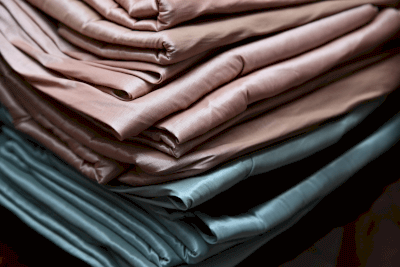What Is Cupro?

Cupro is a type of natural fiber.
Also called copper ammonia rayon, its raw material is cotton linter. Cotton linter is a fiber that grows densely around the seeds (cottonseed) of cotton, which is also the raw material for cotton.
Cotton is a natural raw material that is gentle to both the environment and the human body, and it is easy to use even for those who are constitutionally incompatible with chemical fibers and experience itching. Cupro also has characteristics similar to cotton, such as excellent moisture absorption, moisture release, and texture.
Uses of Cupro
The main use of Cupro is for clothing worn as a luxury fabric. It is used for the lining of suits and suits, underwear, and underwear, where a comfortable feeling is required. It is also often used for curtains, futons, and cushions for interior decoration.
Cotton linter, the raw material of Cupro, is produced in smaller quantities than cotton because only the seed portion (cottonseed) contained in cotton can be extracted. In addition, Cupro has a circular cross section and a smooth surface, which gives it a luster and soft feel, giving it a luxurious feel. For these reasons, it is a relatively high-priced fiber.
Since it is susceptible to friction caused by washing and difficult to care for at home, many products supplement its resistance to friction by blending it with other materials. Recently, as the price of Cupro has come down, it has come to be used not only for durable goods such as clothing but also for consumable items such as masks. Cupro has high moisture absorption and desorption properties, making it possible to produce masks that are less susceptible to steam.
Cupro and rayon also contain a certain amount of moisture in their fibers, and their high thermal conductivity and thermal diffusivity, among other factors, give them an excellent contact cooling sensation, making them the preferred choice for summer masks.
Principle of Cupro
Although Cupro is made from natural raw materials, it is classified as one of the chemical fibers called regenerated cellulose fiber, similar to rayon, polynosic, and Riocell, and is also known as Bemberg. While it has been talked about as being gentle to the environment and to the body because it is a natural material, it is also weak against friction and prone to fluffing, and its durability is not very good.
However, its wet strength, which indicates its strength when wet with water, is much the same as its normal strength, making it more resistant to water than rayon. As for heat resistance and temperature resistance, like rayon, it neither softens nor melts, but it colors and decomposes at about 300°C.
Unlike silk, it is highly resistant to discoloration caused by sunlight, but its strength decreases slightly after prolonged exposure to the outdoors. Other features include resistance to static electricity, softness, suppleness, and smoothness (drape). It also has excellent dyeability, with a wide variety of colors, and can be used to produce deep colors that do not fade easily, enhancing the sense of luxury.
Other Information on Cupro
Manufacturing Process of Cupro
Cupro is manufactured by dissolving cotton linter, which is a short fiber of 2 to 6 mm, once in a copper oxide-ammonia solution to extract only the cellulose, and then processing it again as fiber. Cotton linter is too short to be processed into cotton yarn, so it is converted into fiber by the method described above (copper ammonia method).
Cupro means “copper,” and this process is the origin of its name. Rayon, for example, is made by dissolving wood pulp with chemicals and extracting cellulose to make fiber. Rayon and Cupro are made by a similar process, but the starting material is different.
Cotton linter, the raw material for Cupro, has been attracting attention since cotton was first used as a fiber material. 1884 saw the discovery of know-how for manufacturing rayon fiber from cellulose, and production of this chemical fiber began in 1890, almost the same time as rayon fiber.